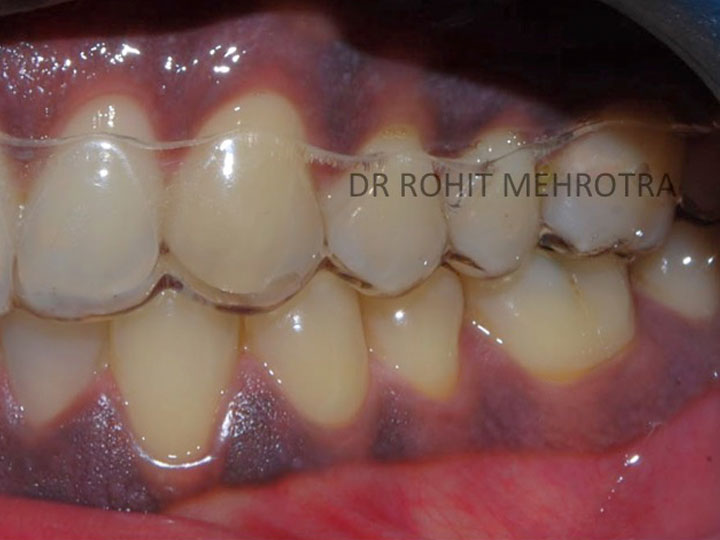Orthodontic appliances are broadly classified as Removable (which can be removed and worn by the patient) and Fixed (which are stuck to the teeth for the duration of the treatment and cannot be removed by the patient). Fixed appliances have more control over tooth movement, thus giving better results and are preferred over removable appliances for the treatment of most types of orthodontic problems. Removable appliances find limited use as adjuncts during fixed appliance therapy, for growth modification therapy and as retainers after orthodontic treatment.
Types of Braces
Fixed Appliances
- Metal braces: Most of the patients taking orthodontic treatment are given stainless steel braces. They can be used for both children and adults (though most adults prefer less visible appliances) but are specially recommended for children as they are extremely efficient, highly cost-effective and relatively easy to care for and handle for both patient and orthodontist.
- Coloured Braces: Generally preferred by children, these are usually metal braces which can be provided in a wide variety of colors. The colors of the braces can be changed during the treatment.
- Ceramic Braces: Compared to metal braces they have the advantage of being much lesser visible but are slightly costlier. Since ceramic is a brittle material, they also require slightly more care on the part of the patient. They are recommended for late teenagers and adults who want a less-visible alternative to metal braces.
- Lingual (Invisible) Braces: These are truly invisible appliances as they are fitted on the inside surface of teeth. They are recommended for adults and late teenagers who want to avoid being seen wearing braces. Most orthodontic cases that can be treated with traditional braces (on the outer surface of teeth) can be given equally good results with lingual braces.
The various commonly used parts of fixed appliance include :
- Bands – A ring made of metal normally fitted around back teeth
- Brackets – The attachments which are bonded to all the front and side teeth to which the archwire is tied. These can be metallic or made of tooth-colored material
- Tubes– Another attachment normally welded to bands or directly bonded to back teeth which has Tube like holes for receiving the archwire
- Archwire – The large wire that is tied into brackets and tubes used for applying pressure to the teeth.
- Ligature wire – Very thin wires used for tying the archwire into brackets or for tying teeth together.
- Ligature rings or modules – Small rings made of rubber used for tying archwire into brackets.
- Separators – Usually placed at the beginning of treatment between back teeth to create space to fit bands. These are normally small brightly colored rings made of rubber. In certain situations, certain metallic springs may be used as separators.
- Chain elastics – Elastics in the form of a chain of interconnected rings tied to brackets and/or tubes to close space between teeth.
- Coil springs – Small spiral springs (like springs used in some ballpoint pens) tied between brackets and/or tubes to open or close spaces between teeth.
Various parts of Braces
Clear Removable Aligners (Invisalign)
One of the recent developments in orthodontic treatment for adults and teenagers is the use of clear removable aligners. These aligners are removable appliances which are absolutely transparent and hence almost invisible when fitted over teeth. Being removable, the patient can also take them off on socially sensitive occasions. A sequence of these aligners can now be used to correct orthodontic problems in both teenagers and adults.
Arguably the most advanced and most globally popular clear aligner system is “Invisalign”. Dr. Rohit Mehrotra is a certified provider of Invisalign.
Retainers
- Retainers are appliances given at the end of active orthodontic treatment to stabilize the corrections. These are of two types – fixed and removable.
- Removable retainers may consist of a plate with visible wires (Hawley’s Retainer) or made of transparent material without wires (Essix Retainer) which is comfortable and virtually invisible when worn over teeth.
- A fixed retainer is a segment of a special wire which is usually bonded to the inside surface of front teeth. This is extremely comfortable, totally unobstructed and invisible. However, it requires proper oral hygiene care by the patient. This can be kept in the mouth as long as necessary and is especially useful in cases where long-term retention is required.












